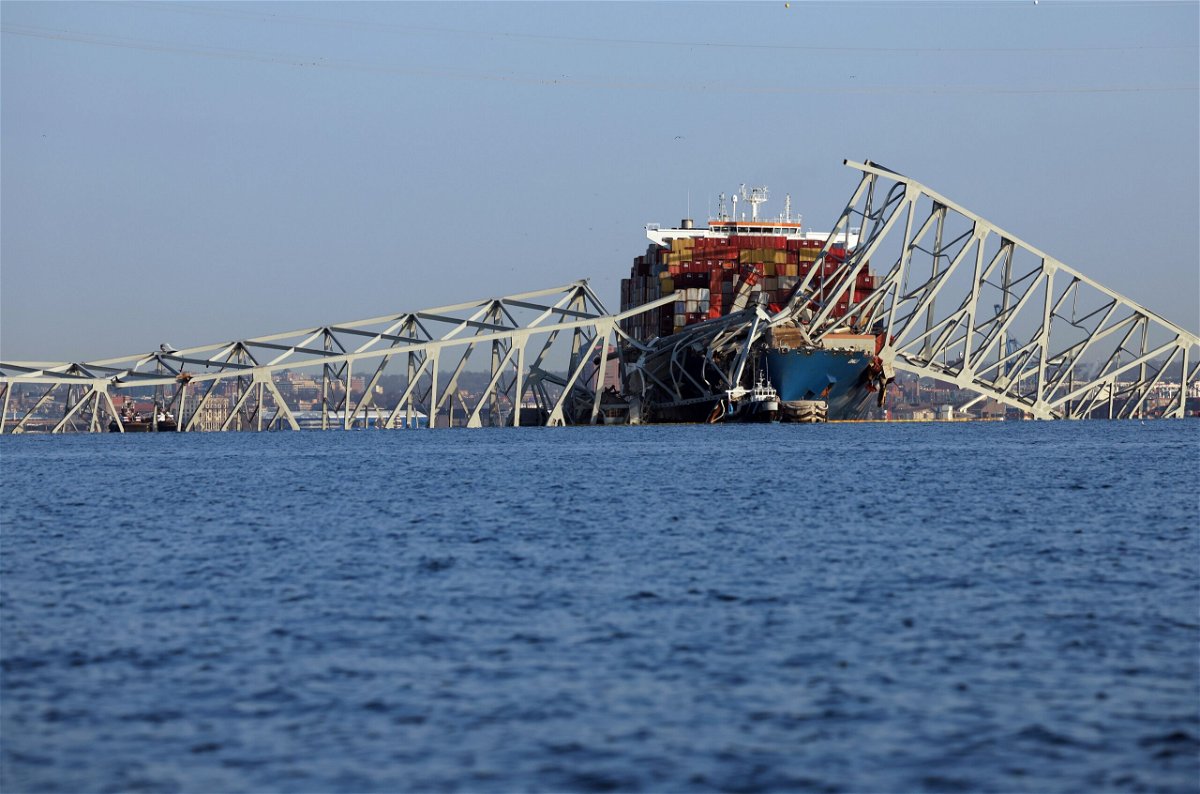1 in every 13 bridges in America is in ‘poor’ condition. Thousands could collapse from a collision

By Nathaniel Meyersohn, CNN
A container ship colliding into the Francis Scott Key Bridge in Baltimore is drawing attention to potential vulnerabilities among some of America’s more than 600,000 bridges.
The Key Bridge stood for 47 years, and in that time it never received the sort of jolt that anyone could have thought would bring it down. But when the Dali, a ship weighing more than 100,000 tons, smashed into it, the bridge tumbled in less than a minute. While such a catastrophic collapse might not have been entirely predictable, bridge collapses as the result of collisions aren’t entirely unheard of, and this one may have been avoidable.
Recent federal safety inspections of the Key Bridge found it to be in “fair” condition, and Maryland’s governor said the bridge was “fully up to code.” But thousands of US bridges are in bad shape.
In America, 46,000 bridges have aging structures and are in “poor” condition, and 17,000 are at risk of collapse from a single hit, according to the American Society of Civil Engineers and the federal government.
Extreme weather events, increasingly heavy trucks and collisions from larger container ships pose significant risks to US bridges, engineers and other infrastructure experts say.
Aging infrastructure
States inspect US highway bridges at least once every two years and classify them “good,” “fair” or “poor.” A bridge found to be in poor condition has some structural elements of the bridge in a state of “advanced deterioration.”
Around 46,100 of the 617,000 bridges across the United States, or 7.5% of all bridges, are considered structurally deficient and are in poor condition, according to the American Society of Civil Engineers’ most recent infrastructure report card released in 2021. 178 million trips are taken across these structurally deficient bridges every day.
While structurally deficient bridges are not inherently unsafe, they require substantial investment to maintain, the organization says. They are at higher risk for closures or weight restrictions.
The good news is that the number of structurally deficient bridges has dropped in recent years, according to the group. But the bad news is that the rate of spending on improvements has slowed. A recent estimate for the nation’s backlog of bridge repairs was $125 billion.
The $1.2 trillion federal infrastructure law that passed in 2021, which includes $110 billion for roads, bridges and major infrastructure projects, could help pay for some bridge improvements.
Climate change and heavier trucks
Many of the country’s older bridges are vulnerable to extreme weather events, such as earthquakes, hurricanes or elevated heat.
Nearly 21,000 bridges were found to be susceptible to having their foundations threatened during extreme weather events, according to the American Society of Civil Engineers’ 2021 report.
Earthquakes are also a significant threat to bridges.
The seismic resilience of the US highway system has improved in recent decades thanks to investments in new, more resilient infrastructure and the retrofitting of existing structures, a 2016 report from the Congressional Research Service found.
Still, not every highway has been retrofitted, and there is not yet a way to build infrastructure in a way that is both cost effective and which can withstand the most intense earthquakes, the report said.
Additionally, bridges are strained by trucks that are heavier than those the bridges were originally designed for.
These heavier trucks, which can surpass 40-ton loads, threaten to over-stress bridge elements, cause metal fatigue and cracking, and decrease bridges’ lifespans, the American Society of Civil Engineers’ report said.
Larger cargo ships
Aging infrastructure, extreme weather and bigger vehicles aren’t the only concerns.
More than 17,000 bridges are vulnerable to collapse from a single hit, known as a “fracture critical” bridge. That means that if they are struck with enough force in just the right spot, a big section or the entire bridge could collapse.
The Key Bridge was “fracture critical,” the National Transportation Safety Board said Wednesday.
There is an urgent need to improve or protect old bridges to guard against larger and larger modern vessels, experts say. The Dali, which slammed into the Key Bridge Tuesday, was 984 feet long — nearly twice the length of the ships used when the bridge was built during the 1970s.
Between 1960 and 2015, 35 major bridges across the planet collapsed because of ship or barge collisions, resulting in 342 deaths, according to a 2018 report from the World Association for Waterborne Transport Infrastructure.
During the first three months of this year, the Key Bridge collapsed in Baltimore, a bridge in southern China was sliced in half, and parts of a bridge were cut through in Argentina after large commercial ships collided with them.
“Ships have gotten bigger, and container ports are focused on deepening their cargo. While we are encouraging bigger containers, we need to protect bridges in these one-off situations,” Ananth Prasad, president of the Florida Transportation Builders’ Association, told CNN.
To minimize the potential of ships bringing down bridges, bridges need to be built with what are known as redundancies— protections around bridges’ danger points.
These include “dolphins” — structures rooted in the seabed or riverbed, extending above the water, typically made from timber or steel — or “fenders” — structures that move objects away from vulnerable points on the bridge to deflect some of the force if there is an impact.
Adding these counter-protections, Prasad said, is quicker and more cost effective than building a new bridge.
“We may need to look at the protection systems around bridge columns in light of bigger ships,” he said.
CNN’s Jessie Yeung, Curt Devine, Casey Tolan and Isabelle Chapman contributed to this article.
The-CNN-Wire
™ & © 2024 Cable News Network, Inc., a Warner Bros. Discovery Company. All rights reserved.